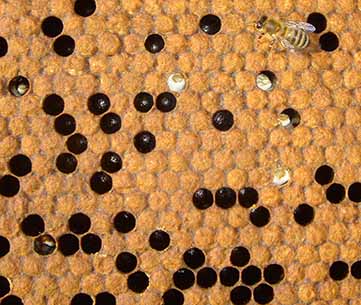The essential information regarding Chalkbrood rot

Contents
- 1 Do you have a passion for raising bees or to be a beekeeper? This article will educate you on Chalkbrood rot, a dangerous illness that poses a threat to bee colonies.
- 2 Chalkbrood rot disease signs and symptoms
- 3 Where the illness that causes Chalkbrood rot is found
- 4 Treatment for Chalkbrood rot
- 5 strategies to avoid the disease Chalkbrood
- 6 Can Chalkbrood be avoided?
Do you have a passion for raising bees or to be a beekeeper? This article will educate you on Chalkbrood rot, a dangerous illness that poses a threat to bee colonies.
Chalkbrood rot disease signs and symptoms
Chalk brood disease affects honey bee larvae, and it spreads during the spring and early summer in areas that are chilly and moist. Since the stage of the larva that is four days old is the most susceptible to this disease, it appears when nectar and sugary feed become more moist. The spores of the fungus that causes the fungus in which the affected larvae turn mummified white are the source of the disease’s name. The spores that grow in the alimentary canal give the fungus its characteristic white hue, which continues to develop until it penetrates the body wall and forms a cottony layer. The larva then contracts to a powdery shape that is simple to capture rupture, and the larva develops gray with black markings throughout the germination process.
Where the illness that causes Chalkbrood rot is found
![]()
Because this disease is frequently found in the outer edges of the brood disc, some people thought that males were more susceptible to it. However, it was later discovered that the low temperature, in addition to the dearth of bees to fill the outer edges of the brood, is what causes this disease to spread to these areas.
Treatment for Chalkbrood rot

We mention the following as a course of treatment for this illness: We remove the diseased offspring and replace them with fresh tires from another cell. The base is then cleaned and turned over; it’s vital to replace the base annually. If the hive is weak, three frames will do for the bees to collect on while we add additional frames made from different cells, some of which have eggs on the borders and honey and pollen within. A few days later, we set up additional tires and fed them terramycin-laced sugar solution. It is important to note that some people have attempted using thymol at a concentration of 0.7 percent or human antifungals as a treatment for the illness We spray it into the diseased cells since bees will not accept the sugar solution that has been added to the thymol. Tragriseofulvin was utilized by others at a rate of 1 cm per liter of sugar solution. However, no cure for this illness has been identified as of yet.
strategies to avoid the disease Chalkbrood

- We take out the damaged discs and position the cells in regions that are well-aerated and exposed to sunlight.
- To bolster the impacted communities, we introduce bees.
- In order to lessen the severity of the infection, it is advised to utilize honey with a water content of less than 17% in the affected hive.
- choosing honey bees from disease-resistant breeds, like the Italian bee breed.
Can Chalkbrood be avoided?

Although chalkbrood can cause a decrease in bee populations and honey production as well as the death of afflicted larvae, it seldom results in the collapse of a colony. But because some strains of honey bee are inherently more resistant to chalkbrood than others, it can be problematic, and the most common cure for reoccurring chalkbrood is to re-queen the colony. Maintaining hives clean, replacing storage and brood combs on a regular basis, and keeping hives dry and well-ventilated are all management strategies to lower the risk of chalkbrood infection. The environment is particularly resistant to spore growth. Therefore, it’s crucial to use clean tools and avoid moving materials across colonies if an infection is present. Pollen, honey, and wax may contain chalkbrood spores, which can be transferred to neighboring colonies by transferring these products.







